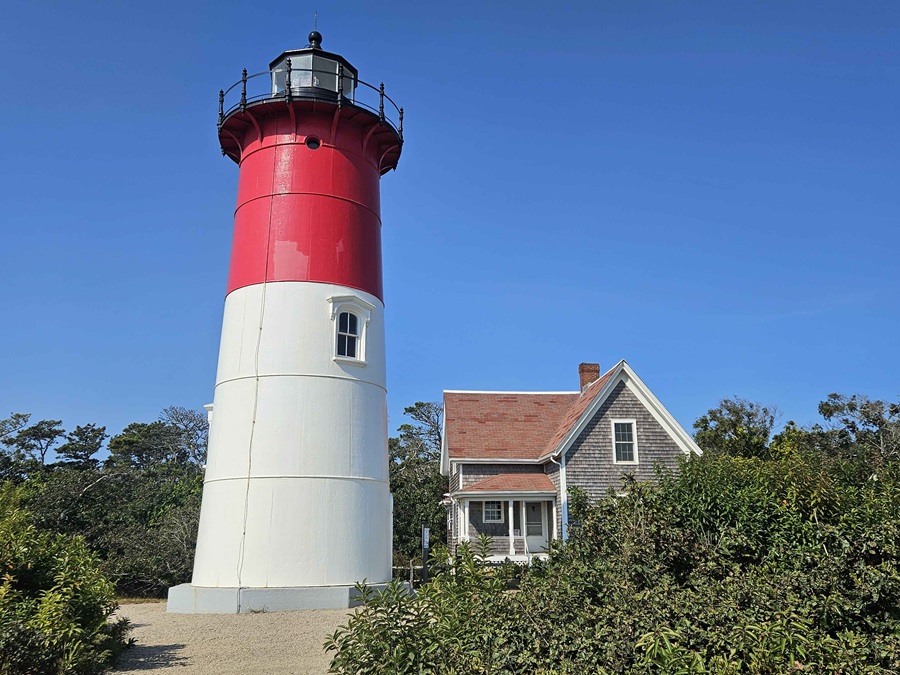EASTHAM — The small house on the edge isn’t everyone’s idea of a dream vacation home. There’s no air conditioning, and a constant stream of visitors crowds the front lawn, with people posing for family photos. Pets and campfires are forbidden.
But the fact that the antique near Coast Guard Beach is available for weekly rentals is remarkable in itself. It represents years of planning by the nonprofit Nauset Light Preservation Society, the National Park Service, and the last private owner of the house.
The keeper’s house was built in 1875 next to the Three Sisters, a trio of masonry lighthouses that helped ships navigate the treacherous waters off Eastham’s shore from 1838 until the early 1890s. In 1892, as the original sisters fell into the ocean, a new, more mobile trio was constructed out of wood next to the keeper’s house.

Operating three separate lighthouses proved inefficient, and by 1911 only one was still in use. In 1918, the others were sold as a summer home to Helen M. Cummings, who moved them to their present location off Cable Road.
In 1923, the brick-and-cast-iron lighthouse now known as Nauset Light was moved from Chatham to replace the lone remaining sister, which had fallen into disrepair. Nauset Light was 200 feet from the cliff, and the keeper’s house was moved to stand beside it. This was the third generation of lighthouses the keeper’s house had seen.
The house was home to 11 lighthouse keepers and their families until the 1950s. In 1952, the revolving light atop the structure was automated with an electric lamp and mercury float pedestal — which meant a keeper was no longer necessary. The lighthouse’s owners, the U.S. Coast Guard, put the house up for auction. It passed through several private owners until 1981, when it was purchased by Mary Daubenspeck, who stayed there intermittently until her death in 2001.
Daubenspeck faced a conundrum in the 1990s, when erosion forced the moving of both lighthouse and keeper’s house back from the edge of the cliff.
Daubenspeck could have chosen to move the keeper’s house elsewhere, thereby retaining ownership of the house, but she decided to keep it near Nauset Light and on Cape Cod National Seashore land. She donated the building to the Seashore in exchange for a 25-year residency for her family. The house was conveyed to the National Park Service when the residency ended in April of this year.
The Nauset Light Preservation Society operates the building on behalf of the Seashore, which cannot afford to maintain the house on its own. The Preservation Society opened the keeper’s house to renters in mid-June of this year. Since then, four groups have stayed there, each for four to seven days. The Preservation Society will use proceeds from the rentals to maintain and renovate the historic building.
Inside the house is a wealth of artifacts. The original icebox stands in the kitchen, and books from the libraries of previous tenants line the shelves in almost every room. Hidden in the basement is an empty “library box,” a wooden trunk that government officials would have filled with books to entertain the keeper and his family. According to Susan Abbott, president of the society, these boxes were brought from lighthouse to lighthouse along with all the supplies the keepers needed to keep their lights running.
This basement, constructed in 1998, is the only addition the house has ever had. The 1,428-square-foot cottage is remarkably spacious — big enough for the keeper’s family, though Abbott says her organization wants to be clear that this is not a place for parties.
“We want to attract people who love historic houses, and we think those people are going be respectful,” Abbott says.
The Preservation Society modeled its plan for the keeper’s house on the work of the Cape Cod Modern House Trust, which has restored four modern houses in the National Seashore and cares for them as part of a long-term agreement with the Park. Abbott hopes her group will follow the trust’s example, bringing in revenue from rentals but also hosting artist residencies, school groups, and community tours.
Many visitors to Nauset Light don’t realize that the keeper’s house has a longer history in Eastham than the lighthouse itself, Abbott says. The society also plans to restore some of the original elements of the keeper’s house, which has changed somewhat since its construction. Early 20th-century photographs of the house reveal ornate “gingerbread” trim hanging from the edges of the roof, for example, and Abbott hopes to bring these and other Gothic Revival elements back.
One modern change that Abbott says the nonprofit does not plan to reverse is the addition of indoor plumbing. While the decoration might be revisited — the house’s two bathrooms currently feature bright red furnishings and Hollywood-style marquee lightbulbs around the mirrors — the convenience of running water is undeniable. Only a few Eastham buildings had running water in 1875; the Penniman House, constructed in 1868, was the first to have a flush toilet — but guests can rest assured that they do not have to live exactly like the keepers did.
Visitors can rent the house through the Nauset Light Preservation Society website. The rate is $2,002 for a week or $8,580 for a month.



